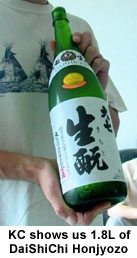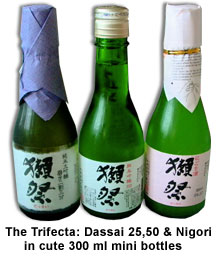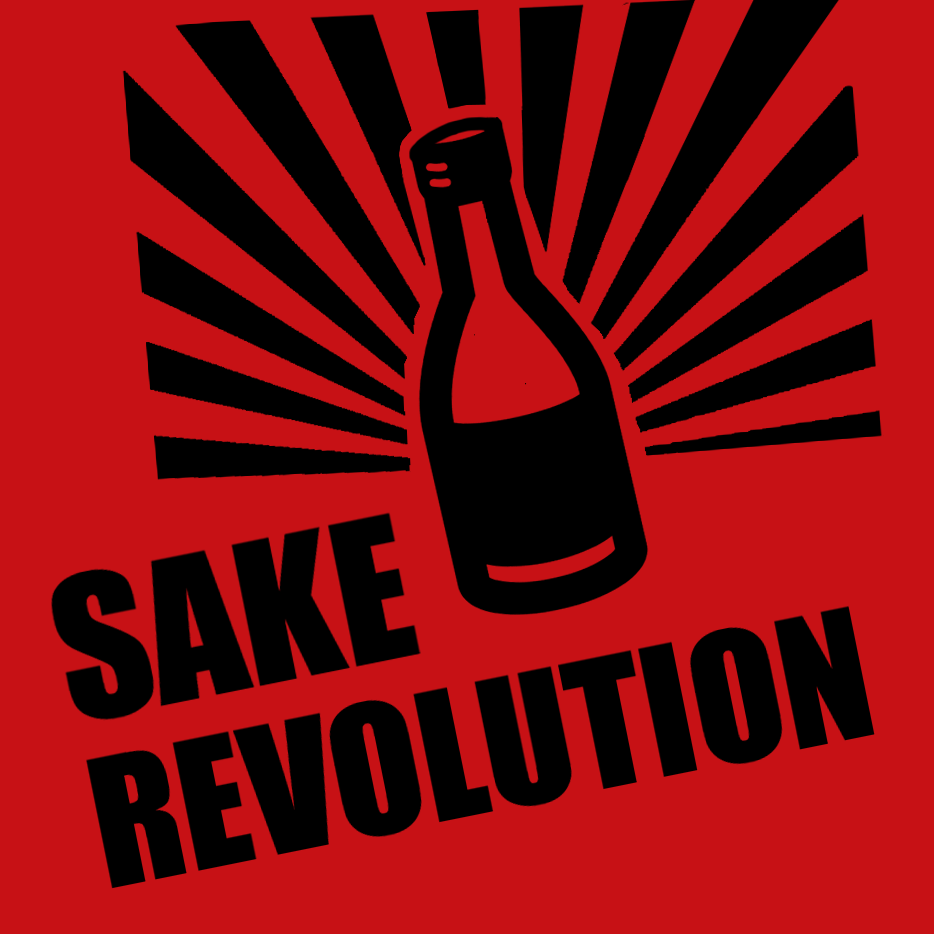Movin’ on up, to the East Side…
 Just like Weezie and George Jefferson, I made my way on up to the East Side last sunday afternoon. It’s not a common haunt of mine, but predictably, it was sake that lured me out of my geographic comfort zone.
Just like Weezie and George Jefferson, I made my way on up to the East Side last sunday afternoon. It’s not a common haunt of mine, but predictably, it was sake that lured me out of my geographic comfort zone.
My Sake Buddy KC organized a really fun and relaxed B.Y.O.S. event at the ‘De-luxe apartment in the sky’ of his friend Hideo. Guest of honor was again our friend Mr. Sakurai, of Dassai Brewery who is in New York for a few weeks.
The set up of our event was simple, everyone bring your own sake with appetizers provided and dinner afterwards. Let’s start tasting!
 1) DaiShiChi Kimoto Honjyozo (SMV +1, ALC 15.5%)
1) DaiShiChi Kimoto Honjyozo (SMV +1, ALC 15.5%)
KC suggested we start with the largest bottle as that would take the longest to finish. I like the way this guy thinks! So, we popped open the huge 1.8L bottle. There is really something festive about these huge bottles. Having them around means you’re having a party or at least a lot of people over for drinking. DaiShiChi is an interesting brand. As faithful readers of my blog know, this is the company that makes, quite possibly, the world’s best sake, Daishichi Myouka Rangyoku.
The DaiShiChi Kimoto Honjyozo was, of course, not in that league, but it’s fun to look for a family resemblance. This Brewery is known as an innovator in the Sake production process, being especially well known for their unique method of milling the rice. The Kimoto Honjyozo had a noticeable grainy flavor. It hinted at a dryness that was more pronounced that you might expect for a sake with an SMV of only +1. A good way to get the party started.
 2) Masumi Okuden Kantsukuri (Junmai, Seimaibuai 60%)
2) Masumi Okuden Kantsukuri (Junmai, Seimaibuai 60%)
Masumi is another well known brand that takes it’s production methods seriously. With a SeimaiBuai of 60%, this sake could technically qualify as a Ginjo, but they choose to to keep it labeled a Junmai. I found this sake to be sprightly, very clean tasting, and a touch on the dry side. KC was telling me that the especially long and colder fermentation of this sake makes for a more complex taste. And I think the bottle shape is cool.
 3) Otokoyama Momenya Tokubetsu (Junmai, ALC 15.5%, Seimaibuai 55%)
3) Otokoyama Momenya Tokubetsu (Junmai, ALC 15.5%, Seimaibuai 55%)
Yet another sake from another really well known brewery. Otokoyama is well known for it’s “Man’s Mountain”. This is a Tokubetsu Junmai take on their Manly-Man traditional Junmai. I was excited to taste and see what I’d find. To my surprise, I initially noticed a flat taste. Then came an earthy, grainy, expressive palate… finishing up with a very Otokoyama-ish super dry finish.
4) Tomoju Junmai Ginjo (SMV +2, ALC 15.5%)
This was a treat from a brewery I know a little less well – Aiyu Brewery in Ibaraki Prefecture. I found the taste to be medium dry. and well balanced. This would be considered a “rich type” sake. We all agreed there was a looooong finish. Quite a treat. Maybe I should get to know Aiyu a little better.
5) Kurosawa Junmai Daiginjo (ALC 15.5%)
Next we had a sure fire winner – and I wasn’t disappointed. Kurosawa is a superstar that always comes through, at all their grades. This was my first time trying the Junmai Daiginjo, so I was like a kid at Christmas when this one hit the table. I was interested to learn that they only make 1500 bottles a year of this Daiginjo grade. That’s not a lot… it made it taste even more special. In brief, I’m in love. This gem was super clean and delightful – A classic Daiginjo with great balance and elegance.
 6) Dassai 23:
6) Dassai 23:
Sakurai-San stepped up to the plate next. He brought with him the “trifecta” of Dassai goodness. In the spirit of “eat dessert first” we went straight for the superlative Dassai 23 Daiginjo. This Sake has been profiled here before. The rice used to make this elixir is milled down to 23% of it’s original size before brewing. That is the smallest seimaibuai in the known universe. It’s light, but flavorful with hints of the most delicate fruit. Being both complex and balanced, this is a sake for serious sipping. you don’t want to be distracted from the flavors by anything. This sake demands your full attention!
7) Dassai 50:
Next was the Dassai Ginjo with a seimaibuai of 50%. This sake tastes fresh and easy to drink. It’s not fussy or overly complicated, but just plain good! Sakurai-san told us this makes up 70-80% of the Dassai production. I understand why it’s so popular.
8) Dassai Nigori: (Seimaibuai 50%)
Last was the Delightful Dassai Nigori. For those Nigori fans out there, this one can’t be beat. Scott and I brought this sake (with mixed results) to Thanksgiving dinner as a dessert wine. I enjoyed it, but I think most guests didn’t know what to make of it. The wonderful thing about this unfiltered sake is the slight hint of fruit with a touch of natural carbonation sparkle. And who couldn’t use a little more sparkle in their lives?
 9) Senkin Ginyu Sizuku Junmai Daiginjo (SMV +5, ALC 16%)
9) Senkin Ginyu Sizuku Junmai Daiginjo (SMV +5, ALC 16%)
Last but not least, was MY contribution to the B.Y.O.S. event. I brought a super fruity perfumy Trickle sake. Did I mention this was Fruity, fruity fruity? Trickle sake is made when sake is not pressed through a filter by machine at the end of the process, but when the sake is allowed to drip naturally through the filter. This is a labor intensive process that produces an amazing treat. With an SMV of +5, I tasted more fruity complexity that out and out dryness. remember SMV is just a guidline! This sake was a special treat and akin to having a fruit salad after all that sober dry sake we had at the beginning of the evening. My palate was barely holding together at this point, but that didn’t stop my enjoyment of this yummy treat.
Around this time, our chinese takout arrived and I was never so happy to see a dumpling in my life. After 9 taste tests of all kinds of sake, I needed some grub. I’m telling you – you haven’t lived until you paired a trickle Junmai Daiginjo with steamed shrimp dumplings.
Then it hit me – Now I finally see that the Upper east side is nothing to be afraid of. As a matter of fact, it’s quite nice! Sorry, George and Weezie… your secret is out.


